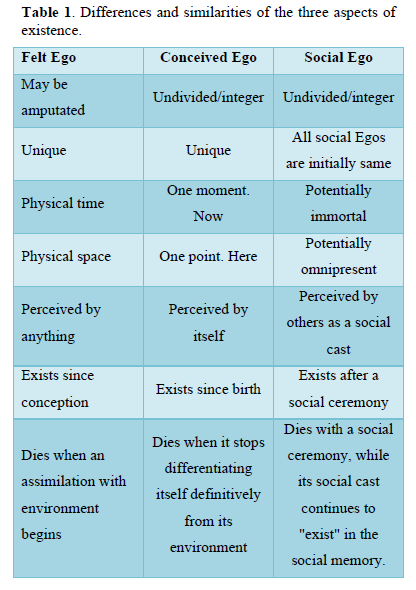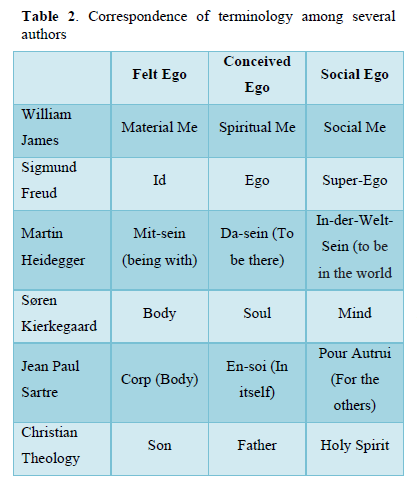2634
Views & Citations1634
Likes & Shares
THE BEGINNING

The most important of these concern space and time. The felt Ego, as perceived by everybody, lives in the physical space and time. Every moment, it changes its place in space, while the arms of the clock turn around. In contrast, the conceived Ego lives always at the same point: here. And it is as if it is astride the arms of the clock, living always at the same moment: now, even though the arms go on turning around the clock. While the felt Ego changes continuously, the conceived Ego remains always the same. This is because a change means two different values of one magnitude or property in two different moments. However, the conceived Ego exists in only one moment: now. In space there is inhomogeneity, if there are differences in one or more properties between two different points. The conceived Ego lives in only one point: here. The conceived Ego is the same from the moment of its birth up to now; from the top of the felt Ego’s head to the bottom of its toes, even though its material carrier, the felt Ego, is continuously changing and differing from one site to the other. Humans are social animals. The creation of a new human being does not end at his or her birth. Sometime after birth the new being is introduced into society. During a social ritual, like Amphidromia in ancient Greece or circumcision in Hebrew and Moslem societies, baptism in Christian societies or registration in suitable registry office in modern political societies, the new being is introduced in its society. The presence of certain people is required: the being itself, its parents, a special commissioner of the society, a priest or the mayor or an official registrar, and an unrelated member of the society, the godparent. A central element of the ritual is attachment of a name to the new being. A social Ego, a new individual, has been born, integral, indivisible, but not unique. With the ritual just described, the new individual, its parents and the society, all recognize mutually that this human is the child of these parents who all are members of this society. Moreover, the new individual has a name that identifies and distinguishes it from the other members of the society.
THE END
Each being starts existing, auro-regulates itself for some time and finally ends. Ending means that it ceases to differentiate itself from its environment. This may occur in two ways. It either succumbs to external forces or is assimilated with it. The three aspects of the existence will accompany the new human being in all his (her) manifestations from his (her) birth up to death. The new human being grows up. Sometime will die. The three aspects of existence were born at different times. Their end will also be non-synchronous. At some moment the auro-regulation will stop. This homo will start becoming similar to its interval. He(she) will become “ashes to ashes and dust to dust”. The body attains the same physical and chemical constitution as its environment. The atoms forming the body of the felt Ego are “immortal” but start dispersing everywhere, without any preexisting plan: Death of the felt Ego. The conceived Ego dies before the death of the felt Ego. The person itself stops discerning itself from its environment. This process happens regularly every day for a few hours in deep sleep, but it will happen permanently just once for everybody. It is important that the death of the conceived Ego is not simultaneous with that of the felt Ego, since in the few minutes that ordinarily intervene between them, modern medicine may restore the function of the felt Ego together with that of the conceived one. In a typical sudden death due to cardiac syncope, consciousness is lost a few seconds (less than 10 sec) after the heart stops. The brain cells start exhibiting lesions that are reversible if the heart begins beating again. In about 4-5 min the lesions become irreversible and death occurs. In deep coma the death of the conceived Ego may precede the felt Ego's death for a long time. The social Ego dies with a social ritual. It may be a religious funeral, a deletion from the municipal records etc. Obviously, the social death is not simultaneous with that of the felt and conceived death. Until the social death occurs, the departed individual may illegally have a “normal” social life, getting its pension, voting in elections etc. The social death comes only when the individual has definitely been forgotten by everybody. William James, a psychologist and philosopher, describes the material me, the social me and the spiritual me [1] (Table 2).
In the following the terms felt, social and conceived Ego are preferred. By material me he means the aspect of the human being that may be sensed by its physical environment. He defined the social me as the recognition which a man gets from his mates. By spiritual me he means the entire collection of each one’s states of consciousness. The psychoanalyst Sigmund Freud [2] describes correspondingly Id, Ego and Super-Ego. According to Soren Kierkegaard, [3] man is a synthesis of a psychical and a physical element; however, a synthesis is unthinkable if the two are not united in a third one. This third element is mind. Martin Heidegger [4] mentions "In-der-Welt-Sein, Dasein, Mitsein"; and Jean Paul Sartre [5] analyzes "Corp, En-soi, Pour-autrui". All of them refer to the relations of the human being to the universe, to the society and to self respectively. It is remarkable that the Triune God of Christianity has similar aspects. The Father who is inaccessible to the human senses and mind, corresponds to the conceived Ego. The Son, who was seen, heard and touched by his disciples corresponds to the felt Ego. And the Holy Spirit corresponds to the social Ego. Considering the three aspects of our existence may help in understanding several aspects of our life, as e.g. the value of abortion; the three schedules of our daily activities: social, at the business place for professional and political activities, felt, at home for satisfying the somatic needs, and conceived, anywhere in order to do what each one wants provided that it does not interfere with what others want.
- James W (1948) Psychology. Cleveland and New York.
- Freud S (1999) The Standard Edition of the Complete Psychological Works of Sigmund Freud. Vol. XIX. Translated from the German under the General Editorship of James Strachey. In collaboration with Anna Freud. Assisted by Alix Strachey and Alan Tyson, Vintage. Available online at: https://en.wikipedia.org/wiki/The_Standard_Edition_of_the_Complete_Psychological_Works_of_Sigmund_Freud
- Kiergergaard S (1968) The concept of Dread. Paperback - April 1, 1968. Walter Lowrie. Available online at: https://oldcapitolbooks.files.wordpress.com/2020/01/theconceptofdread.pdf
- Heidegger M (2006) Sein und Zeit. Max Niemeyer Verlag Tübingen.Available online at: https://www.amazon.de/Sein-Zeit-Martin-Heidegger/dp/3484701536
- Sartre JP (1943) Being and nothingness. Edition Gallimard. Available online at: https://www.amazon.de/Sein-Zeit-Martin-Heidegger/dp/3484701536
QUICK LINKS
- SUBMIT MANUSCRIPT
- RECOMMEND THE JOURNAL
-
SUBSCRIBE FOR ALERTS
RELATED JOURNALS
- Journal of Carcinogenesis and Mutagenesis Research (ISSN: 2643-0541)
- Journal of Ageing and Restorative Medicine (ISSN:2637-7403)
- Journal of Neurosurgery Imaging and Techniques (ISSN:2473-1943)
- Journal of Rheumatology Research (ISSN:2641-6999)
- Advance Research on Endocrinology and Metabolism (ISSN: 2689-8209)
- Journal of Blood Transfusions and Diseases (ISSN:2641-4023)
- Journal of Pathology and Toxicology Research

